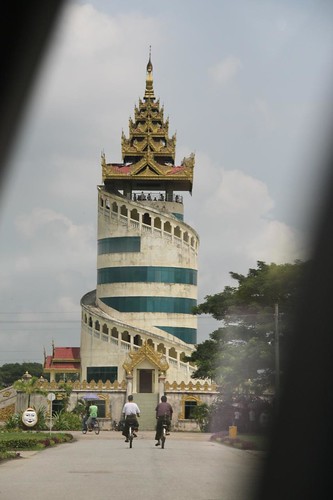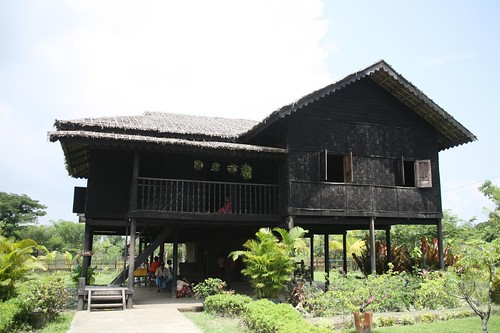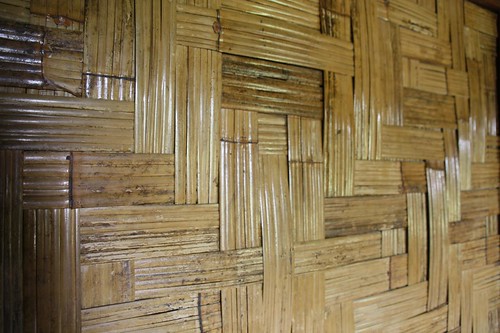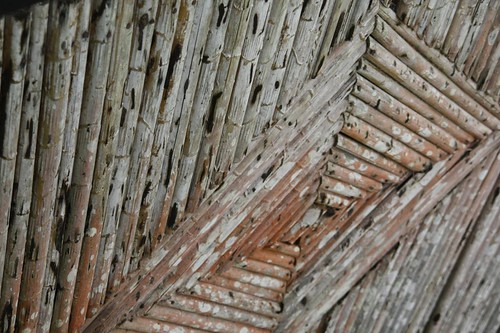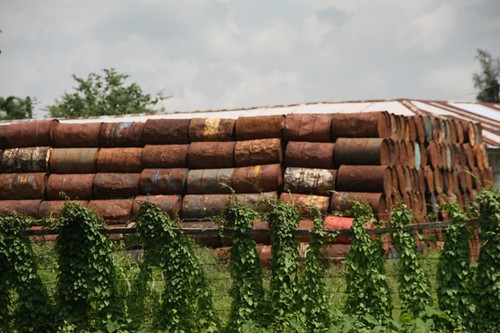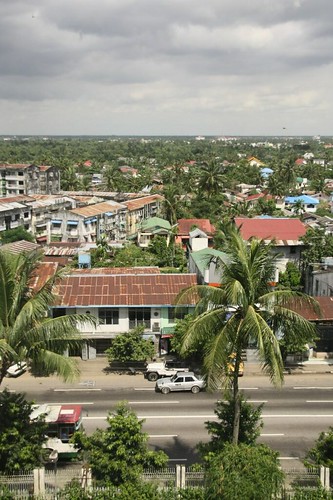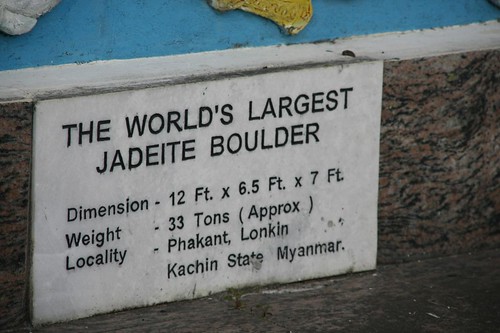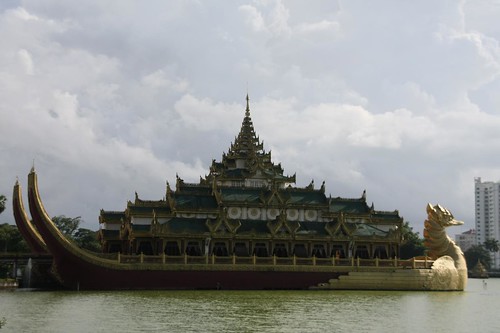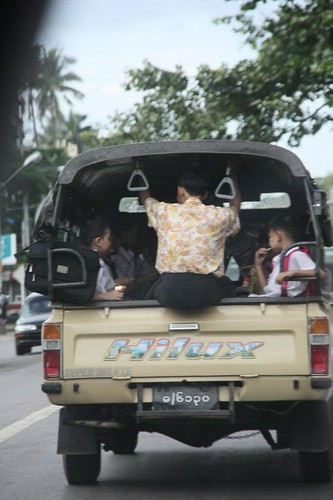The stretch of Strand Road from Botataung Pagoda to Mahabandoola Garden Street was actually a lot further than it seemed from the map. We walked and walked, anticipating for Mahabandoola Garden Street to appear for us to turn into. We passed the Post Office, the British Embassy and the posh-looking Strand Hotel. Policemen surrounded the law court and had barricades installed to prevent pedestrian passage. We were walking ahead when a policeman stopped us and told us to detour. It was a blessing in disguise as we found a comfy Mr Brown cafe to take a break from our long walk. Thanks to the friendly staff at the cafe, we found ourselves walking past the Myanmar Foreign Trade Bank building along the right street and already the Garden where the Independent Monument is located was slowly coming into our view. At the entrance, there were two guards sitting under a standing umbrella. We were told to pay USD2 for entrance.
The obelisk, Independent Monument, in Mahabandoola Garden. There are Chinthe (Chinese lion-looking animals) statues surrounding the monument. It's interesting to see obelisks all around the world. I've seen them in Jakarta, Paris, UK and now, Yangon too!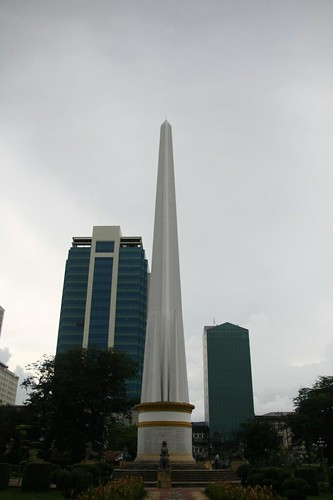 This is the High Court building which I had mistaken for a church. It was funny because I went through the tiny gate door to the guardhouse to ask for entry into this church, where I was instantly refused. When I admired its Victorian architecture from the garden grounds, I realised it looked English but it was nothing like a church!
This is the High Court building which I had mistaken for a church. It was funny because I went through the tiny gate door to the guardhouse to ask for entry into this church, where I was instantly refused. When I admired its Victorian architecture from the garden grounds, I realised it looked English but it was nothing like a church! These two little girls were running around in the gardens while their parents laid resting among some flower bushes. The garden seemed to be a popular date spot as I saw several couples here and there, whispering to each other with shoulders meeting under small umbrellas.
These two little girls were running around in the gardens while their parents laid resting among some flower bushes. The garden seemed to be a popular date spot as I saw several couples here and there, whispering to each other with shoulders meeting under small umbrellas. Inscriptions on the marble walls at the base of the monument
Inscriptions on the marble walls at the base of the monument City Hall
City Hall Banner at the entrance of the Immanuel Baptist Church
Banner at the entrance of the Immanuel Baptist Church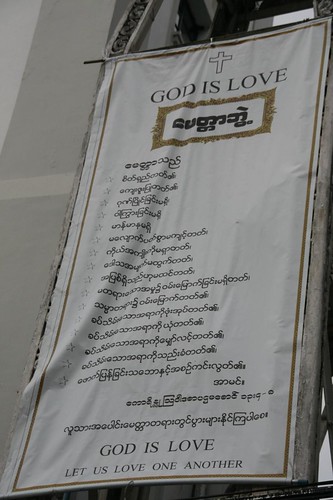
Surrounding the Mahabandoola Garden are some important landmarks such as the City Hall, the Immanuel Baptist Church, the High Court and a famous pagoda, Sule Paya. We met some mobile money changers as we were heading towards the church. We had been warned by Three Season Hotel staff members to avoid doing foreign currency exchanges with mobile money changers. They'd give you an unbelievably good exchange rate while will get you to jump right into the deal. Once the notes are exchanged, money changers are nowhere to be found and you'll realise, in the handed big stack of notes, about a third of it has been folded to make it look thicker than it really is.
It had started to drizzle and the idea of sitting in the church felt so welcoming. The church warden welcomed us and ushered us to the upper floor. The ground floor looked like an office. The church hall looked old but, clean. It was airy as its big windows are open, also allowing much light to enter. I chose a bench to sit and R joined me. In silence and seated, we both looked around. I tried to absorb the spirituality which churches exuberate. It felt serene and gentle. What we find most special about this church is its ceiling. The chandeliers that hung from the ceiling were all different! We caught ourselves laughing at this unexpected finding and the images of this instilled in my mind were comical yet adorable. Did some people donate these to the church? I would not be surprised.
The church hall of Immanuel Baptist Church
 At least, they were symmetrical :)
At least, they were symmetrical :)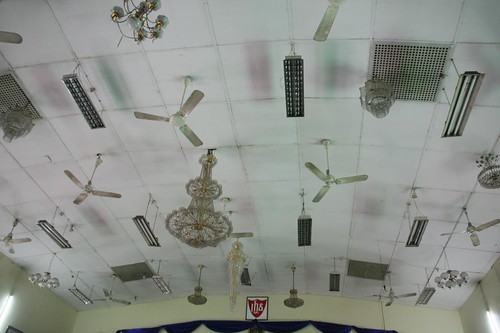 View of Sule Paya from the church's window
View of Sule Paya from the church's window Immanuel Baptist Church
Immanuel Baptist Church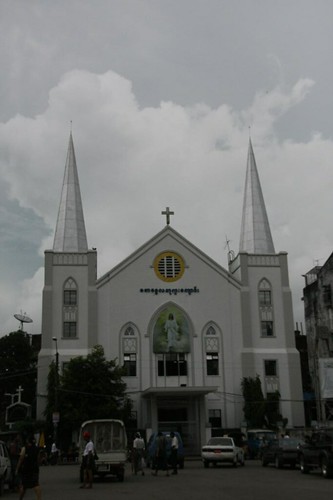
By now, R's foot was hurting more than the morning when we flew from Bangkok. I had asked her to rate her pain from 1 to 10, with 1 being the least and it was 5. She said it might have been an ache which was caused by wearing heels over long hours. I thought if that is the case, the walking would probably not aggravate but, I was wrong. The following day, R began to limp and the pain level might have gone up to 6 or 7, which she later confirmed. We had to see the doctor for her to feel better.
We walked across to Sule Paya as the drizzle was becoming heavier. If I remember correctly, we paid USD2 for each entry and an additional USD1 for bringing a camera. It started pouring heavily when we had barely started our tour around the pagoda. In all the places of Buddhist worship we have visited in and around Yangon, footwear has to be left at the entrance of the temple or pagoda.
Sule Paya Golden roof of many tiers with heavily carved designs
Golden roof of many tiers with heavily carved designs
People in Myanmar likes to know where the tourists are from. While we were viewing the temple's bookshop which sells books on Buddhism in Myanmar language, a friendly elder came and talked to us. He told us of his son who is studying abroad in Japan, upon learning R's origin. I had asked him about the inscriptions that were on cemented slabs surrounding the temple. Apparently, these are name of donors who had contributed to the building and/or maintenance work of the temple.
While it was raining, R and I sat under the shelter to enjoy the ambience. It felt so wonderful with my eyes closed, listening to the sounds of the rain and the bells from the hti.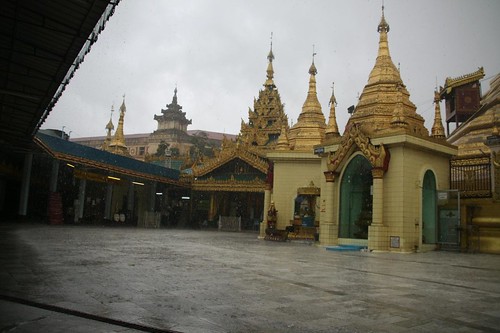 A man praying a prayer room with a big Buddha statue, away from the wetness of the rain
A man praying a prayer room with a big Buddha statue, away from the wetness of the rain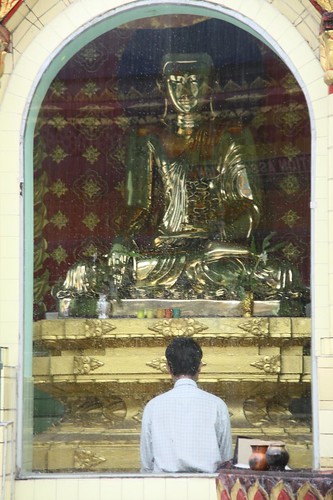 People with umbrellas and places to go
People with umbrellas and places to go
While waiting for the rain to stop, I thought I'd just check the map on Lonely Planet for the Jewish Synagogue and Hindu temple we planning to visit after our late lunch. I was rummaging into my bag, I realised my Lonely Planet book was nowhere to be found. Panic striked. This time, I did a more thorough check and even removed some of the contents from my bag.
No Lonely Planet! Oh dear, where have I misplaced it? R tried to calm me down by recalling when she last saw me refering to the book. I was still refering to the book when we left the garden for the church. It
MUST be in the church! Ok, there wasn't much point to worry although at the back of my head I was thinking,
oh dear, now I don't even know where to go. I felt so lost without the book and it's no fun going to places, not knowing anything about the place. The book is somewhat like the treasure map with all its hints to all these wonderful places.
It's ok, D, it will be at the church, I told myself.
When the heavy rain turned into a light drizzle, we headed back to the church. I had explained to the warden about my predicament and asked if he's seen a book. According to R later, he had actually replied that this is not a bookshop. Hahaha! I was too worried about the book to actually make out what he has said. I asked if he could let me go into the hall to check and he allowed.
I headed straight the bench which I took earlier but, the book was not there. I searched the neighbouring benches and found nothing either. An elder, who must have seen me frantically searching, asked what I might be searching for. Right after my explanation, he led me to a bench on the opposite side of the aisle and
THERE was my Lonely Planet! I could hear an orchestra of violins going
Ta Da in my head! I was overjoyed and relieved beyond words!
We were just about to leave the church when we thought we'd take another break. I know R's hurting whenever she walked and it was a feat on her part to continue the tour. She never complained or asked for breaks, which worried me. Perhaps, her excitement of the trip drowned the pain, I don't know.
We took the bench at the back of the church. When the same elderly man took a young girl's arm and led her down the aisle to the instrumental music of 'Here comes the bride', we realised we were actually witnessing the rehearsal of a church wedding ceremony in Yangon. Watching the scenes of this thrilled us!
Wedding ceremony rehearsal
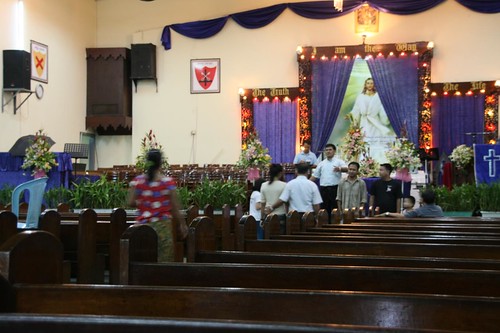
We headed to the street behind the City Hall, in search of the 999 Shan Noodle Shop for a late lunch with a positive cue from Lonely Planet.
Old, mouldy building
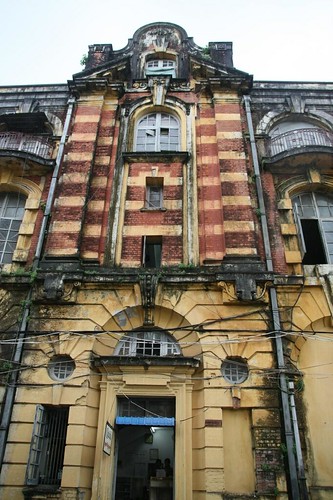 The street where the 999 Shan Noodle Shop is located
The street where the 999 Shan Noodle Shop is located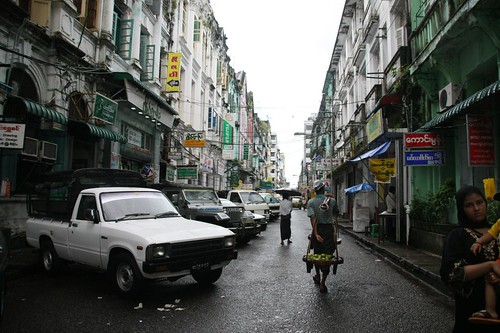 I was so hungry, I ordered two bowls of noodles and shared the second bowl with R. My first order was Hnyat Khauk Swai (Noodle Soup)
I was so hungry, I ordered two bowls of noodles and shared the second bowl with R. My first order was Hnyat Khauk Swai (Noodle Soup)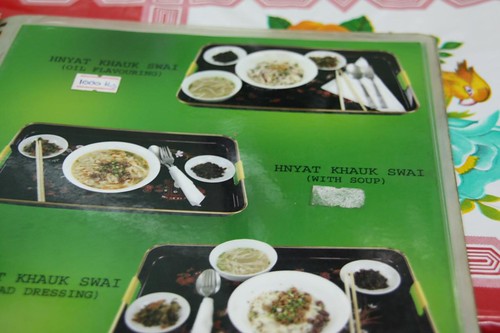 It's spicy and a little oily but it tasted delicious. The steaming hot tea tasted so good and relaxed me from a long day of walking.
It's spicy and a little oily but it tasted delicious. The steaming hot tea tasted so good and relaxed me from a long day of walking.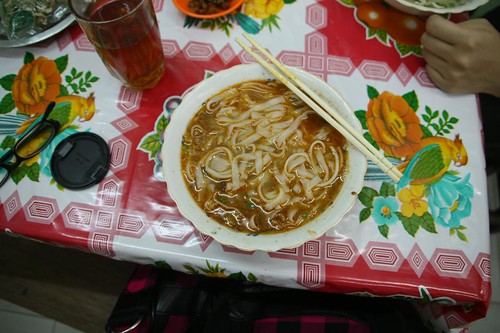 Next order was this Shan noodle, which was under the salad section. I had asked the lady boss if the noodles were served cold and as explained, it wasn't. It tasted good but the first order was still way better. This one is oily and the sauce tasted a little like the sauce used in Rojak. So, it tasted strange to me.
Next order was this Shan noodle, which was under the salad section. I had asked the lady boss if the noodles were served cold and as explained, it wasn't. It tasted good but the first order was still way better. This one is oily and the sauce tasted a little like the sauce used in Rojak. So, it tasted strange to me.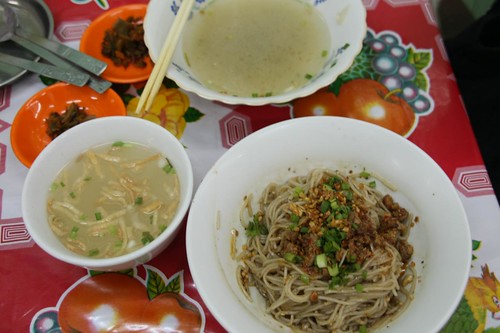
After our lunch, we took a taxi to the Museah (Moseah) Yeshua Synagogue and Sri Siva Temple. The taxi driver, who looked nervous and also, spoke nervously, didn't know where the place is. We showed him the map and explained the directions to him. But, I think he was more lost than we were. It was at the corner of the junction that meets Mahabandoola Road and Konzaydan Street. We weren't sure where we were heading next after we turned into a street from Merchant Street. I think we were dropped off near the Theingyi Plaza, which is two street away from the desired destination. At least, we knew we're on Mahabandoola Road. So, now to find the Jewish and Hindu temples. We walked many streets down but didn't see any temples of these sort. In fact, we almost went into a Buddhist temple, thinking it was Hindu! Hahahaha! I told R that we needed to ask for directions from any ladies with a 'Bindi' (a dot worn on Hindu women's foreheads) and we did eventually find one. She gave us some directions, which we followed, only to be met with a mosque! 0_o
At the entrance of a mosque, a muslim passerby was happy to see us. He explained that the obvious building is a mosque and that it is a hundred years old. A lady sitting at the entrance porch of the mosque pointed at the opposite green building and mustered, "Muslim School".
Busy street along Mahabandoola Road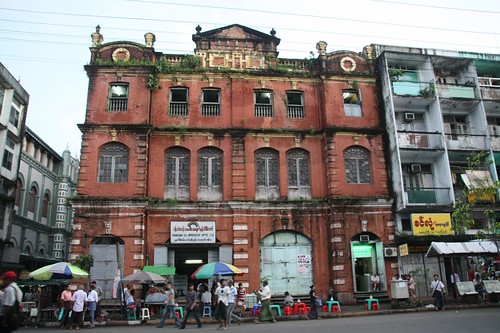 Islamic school, Shwe Bontha Street
Islamic school, Shwe Bontha Street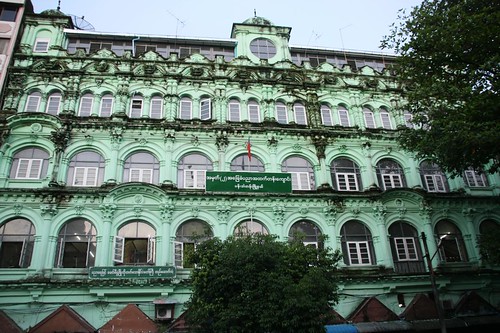 Bengali Sunni (Sunne) Jameh Mosque, Shwe Bontha Street
Bengali Sunni (Sunne) Jameh Mosque, Shwe Bontha Street
It was getting dark, making vision a little difficult in a poorly lit, crowded street with uneven pavements. I watched the ground the entire time, making sure to avoid tripping over unleveled grounds. There were little or no street lights on some streets. The stall vendors installed their own lights or tried to get some light from other stalls that do. Some were literally selling their wares in near darkness.
Uneven pavements and street stalls
 Sule Paya from a pedestrian bridge during dusk
Sule Paya from a pedestrian bridge during dusk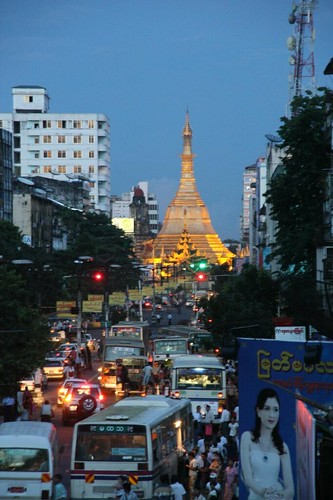
We gave up trying to look for the temples. We tried looking for the buildings from the pedestrian bridge in the hopes of getting a better view, but to no avail. We finally hailed a cab to get back to the hotel. This taxi driver was friendly and spoke more English than the previous one. He drove a muscle car with the interior cushions lining the doors removed. So, you can see the bare metal frame of the door. The interior lamp had been improvised with a primitive switch of joining the wires to connect the circuit. When we asked him for direction of the synagogue, it took him a while to close the circuit to turn on the lamp so that he can see the map on my book. He's extremely nice and we chatted with him all the way till we reached the hotel. He has been a taxi driver for 12 years. Before he became a taxi driver, he was a tour guide 15 years ago. Times were good then, he said. On top of his salary, he was given travel allowance for his traveling expenses outside Yangon when he was running the tours. The tour company he had worked for went bankrupt because tourism became scarce. I asked him for his thoughts on tourism in his country. I am eager to know because I've come across various articles about tourism in Myanmar including websites of
Aung San Suu Kyi being somewhat against tourism for good reasons and another of
her stating that tourism may help. The taxi driver looked demented as he recalled the loss of his job 15 years ago and did think that tourism is good for his people and country. The same sentiment was shared by another driver who brought us to Bago and Thanlyin.
In the days to come, I felt sadden to learn about Myanmar through observation of the places of visit. How can a country so rich in many natural resources from previous stones to minerals, oil and water be housing people that are so poor? The streets and public ammenities are so badly maintained. They have all these natural resources every country dreams of having, yet the people are not even living in conditions half as good at these lacking countries.
 Gems Market and Museum next door to Kaba Aye Pagoda has jewellery shops and museum.
Gems Market and Museum next door to Kaba Aye Pagoda has jewellery shops and museum. Bogyoke Market was first built and inaugurated on the present premises in 1926. It was named Scott Market after Mr. C. Scott, the Municipal Commissioner. Nowadays, it is called Bogyoke Aung San Market in honor of our national leader General Aung San who was assassinated in 1947. Bogyoke Aung San Market is situated in the heart of Yangon - on Bogyoke Aung San Road. There are 1,641 shops selling luxury items, handicrafts, foodstuffs, clothing, jewellery, fashion and consumer goods. The market is open daily from 10:00 am to 5:00 pm except gazette holidays.
Bogyoke Market was first built and inaugurated on the present premises in 1926. It was named Scott Market after Mr. C. Scott, the Municipal Commissioner. Nowadays, it is called Bogyoke Aung San Market in honor of our national leader General Aung San who was assassinated in 1947. Bogyoke Aung San Market is situated in the heart of Yangon - on Bogyoke Aung San Road. There are 1,641 shops selling luxury items, handicrafts, foodstuffs, clothing, jewellery, fashion and consumer goods. The market is open daily from 10:00 am to 5:00 pm except gazette holidays. Chinatown that exotic enclave within exotic Myanmar, makes a visit so much more uniquely, unconventionally informal and fantastically bizarre. A place, however, that you must see and experience, or else trip to Myanmar is marginally incomplete. It is in the evening that the place really takes off and amazing environment unlike any you have ever experienced. The streets are lined with four-story plastered brick town-houses, whitewashed in faded pastel creams, blues and yellows with facades studded with ornamental scrollwork. Since the people in town gather to Chinatown for Chinese food, barbeque, beer and liquor, it bustles on to 2 am with open shops and plenty of good food. The most striking feature in the Chinatown is the hundred of gold shops, fruits and vegetables venders that dominate the both side of the main road. Fruit especially mandarin oranges from the Shan State, apples from Kachin State and China, water-melons, bananas, durian, guava, mangosteen, pear, pomelo,grapes, litchee, plum, rambutan and mango, strawberry at the season.
Chinatown that exotic enclave within exotic Myanmar, makes a visit so much more uniquely, unconventionally informal and fantastically bizarre. A place, however, that you must see and experience, or else trip to Myanmar is marginally incomplete. It is in the evening that the place really takes off and amazing environment unlike any you have ever experienced. The streets are lined with four-story plastered brick town-houses, whitewashed in faded pastel creams, blues and yellows with facades studded with ornamental scrollwork. Since the people in town gather to Chinatown for Chinese food, barbeque, beer and liquor, it bustles on to 2 am with open shops and plenty of good food. The most striking feature in the Chinatown is the hundred of gold shops, fruits and vegetables venders that dominate the both side of the main road. Fruit especially mandarin oranges from the Shan State, apples from Kachin State and China, water-melons, bananas, durian, guava, mangosteen, pear, pomelo,grapes, litchee, plum, rambutan and mango, strawberry at the season. On one side are the glass enclosed display counters in which gold ornaments, predominately rings, necklaces and pendants. Sidewalk diners have dishes and delicacies of egg or wheat noodles, grilled meats, deep fried spring rolls, etc.
On one side are the glass enclosed display counters in which gold ornaments, predominately rings, necklaces and pendants. Sidewalk diners have dishes and delicacies of egg or wheat noodles, grilled meats, deep fried spring rolls, etc.

























